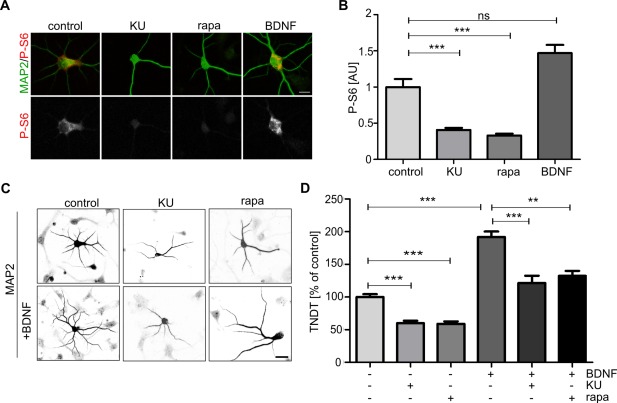Figure 1.

mTOR activity is necessary for proper dendritic arborization of SVZ‐derived neurons cultured in vitro. (A) Representative confocal images of SVZ‐derived neurons immunofluorescently stained for MAP2 and ribosomal protein S6 phosphorylated at Ser235/236 (P‐S6). Scale bar = 25 µm. Two days after plating, brain‐derived neurotrophic factor (BDNF; 50 ng/µL) and DMSO or mTOR inhibitors (Ku‐0063794 [KU], 30 nM; rapamycin [rapa], 20 nM) were added to the culture medium. Four days after plating, the cells were fixed and immunostained. (B) Quantitative analysis of average intensity of P‐S6 immunofluorescence of neurons treated as in A. Number of experiments (N) = 3. Number of analyzed cells (n) = 24 (control), 31 (KU), 32 (rapa), and 26 (BDNF). The data are expressed as mean values normalized to the control. Error bars indicate SEM. ***p < 0.001; ns, not significant (Kruskal–Wallis test with Dunn's post hoc test). AU, arbitrary units. (C) Representative confocal images of neurons treated as indicated in A and immunofluorescently labeled with an antibody against MAP2. Scale bar = 25 µm. (D) Quantitative analysis of number of dendrites based on MAP2 immunostaining of cells treated as in A. The bar graph shows the analysis of the number of dendritic tips as a percentage of the value normalized to the BDNF untreated control in a given experiment. Error bars indicate SEM. Number of experiments (N) = 3. Number of analyzed cells (n) = 123 (control), 72 (KU), 69 (rapa), 105 (control + BDNF), 53 (KU + BDNF), and 72 (rapa + BDNF). ***p < 0.001, **p < 0.01 (Kruskal–Wallis test with Dunn's post hoc test).
